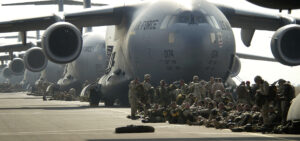REMINDER: This Thursday, October 26, at 7 p.m. Eastern. Austrian economics star Pete Boettke will be our third presenter in our online Austrian conference: “How Austrian Economics Impacted My Life.” Register here to receive your Zoom link.
******
As a consequence of the war between Israel and the Palestinians, U.S. troops in Iraq have come under drone attacks, owing to anger arising from the U.S. government’s unconditional military support of the Israeli government. No U.S. troops in Iraq have been killed as a result of those attacks, but one civilian contractor died of a heart attack during one of the attacks.
U.S. officials have blamed Iranian-backed militia forces in Iraq for the attacks. One militia group, the Hezbollah Brigade, demanded that U.S. troops leave Iraq, declaring “Otherwise they will taste the fires of hell.”
The Pentagon currently has around 2,500 troops stationed on three bases in Iraq. Their mission is to advise and assist the Iraqi regime to resist efforts by ISIS to take control over the country.
One of the fascinating aspects of this phenomenon is how the U.S. mainstream press considers this situation to be perfectly normal. In news accounts of these attacks, no one in the mainstream press asks the obvious question: What in the world are U.S. troops doing in a country that is almost 7,000 miles from the United States? It’s just considered to be a normal part of life in a far-flung military empire that consists of around 900 military bases around the world.
 We shouldn’t forget something important though: Those 2,500 troops in Iraq are the outgrowth of the U.S. attack, invasion, war of aggression, and long-term occupation of Iraq some twenty years ago. In that war, the Pentagon was the invader, the attacker, the aggressor, and the occupier of Iraq, a country whose government had never attacked the United States or even threatened to do so.
We shouldn’t forget something important though: Those 2,500 troops in Iraq are the outgrowth of the U.S. attack, invasion, war of aggression, and long-term occupation of Iraq some twenty years ago. In that war, the Pentagon was the invader, the attacker, the aggressor, and the occupier of Iraq, a country whose government had never attacked the United States or even threatened to do so.
In other words, in the U.S. war of aggression against Iraq, Iraq was always the defending power. The Pentagon was the attacking power, just as Japan was the attacking power at Pearl Harbor. Thus, while American interventionists still celebrate the courage and heroics of U.S. troops in Iraq, they oftentimes ignore the fact that those troops were part of an illegal and unconstitutional (i.e., no congressional declaration of war) invasion and war of aggression, one that violated the principles set forth by the Nuremberg War Crimes Tribunal under which Nazi officials were prosecuted for war crimes that included invading and waging wars of aggression against other nations.
The Pentagon’s objective in invading Iraq was the same as it is with its many other violent regime-change operations — to oust the Iraqi rulers and replace them with U.S. stooges, who would then be expected to do the bidding of Pentagon officials. Ironically, the principal target of this particular regime-change operation was Iraqi dictator Saddam Hussein, who, ironically, had been a partner and ally of the Pentagon during the 1980s, when Iraq was waging its own war of aggression against Iran.
In its war of aggression against Iraq, the Pentagon accomplished its regime-change mission, but only to a certain extent. The regime that it ended up installing into power, even while deferential to the Pentagon, was largely aligned with Iran, which has been the Pentagon’s avowed enemy since 1979. That was the year that the Iranian people violently revolted against the brutal Iranian regime that the CIA had installed into power in 1953 in yet another violent U.S. regime-change operation. That was why the Pentagon was partnering with Saddam Hussein in his brutal war of aggression against Iran during the 1980s.
The Iraqi regime’s deferential attitude toward the Pentagon is what enables the Pentagon to keep those 2,500 troops in Iraq. At the same time, however, the country is filled with Iranian-oriented militia groups that the Iraqi regime has no interest in eradicating.
At one point, U.S. troops had been withdrawn from Iraq. But the efforts by ISIS to take control in Iraq caused the Pentagon to send troops back into the country in 2014, where they have been ever since. Of course, in combatting ISIS, the Pentagon claimed that it was fighting “terrorism,” which is the label imposed on anyone who opposes the Pentagon’s regime-change operations. But the fact is that ISIS included many Iraqis who had opposed the Pentagon’s war of aggression against Iraq and the puppet regime that the Pentagon had installed into power.
Today, the mission of those 2,500 U.S. troops in Iraq is to advise and assist the puppet regime that the Pentagon installed into power. If those militia groups in Iraq succeed in killing any of these U.S. soldiers in retaliation for the U.S. government’s unconditional military support for the Israeli government, their families will be consoled by the notion that their loved one died protecting a brutal and tyrannical puppet regime 7,000 miles away from American shores. Not exactly the most glorious thing to be sacrificed for.



